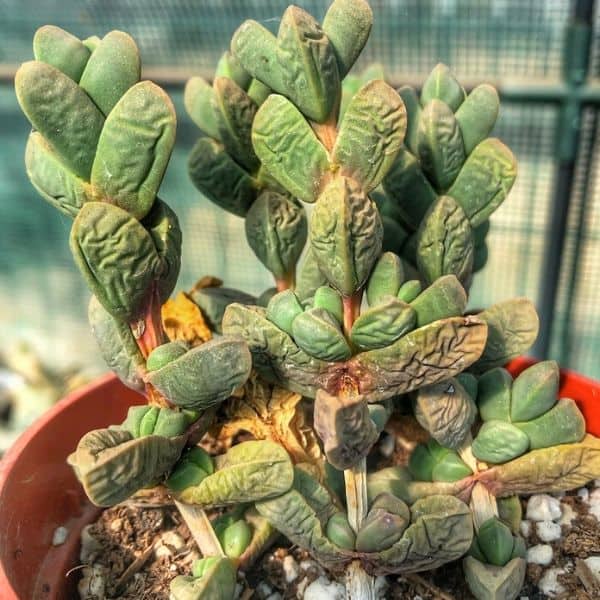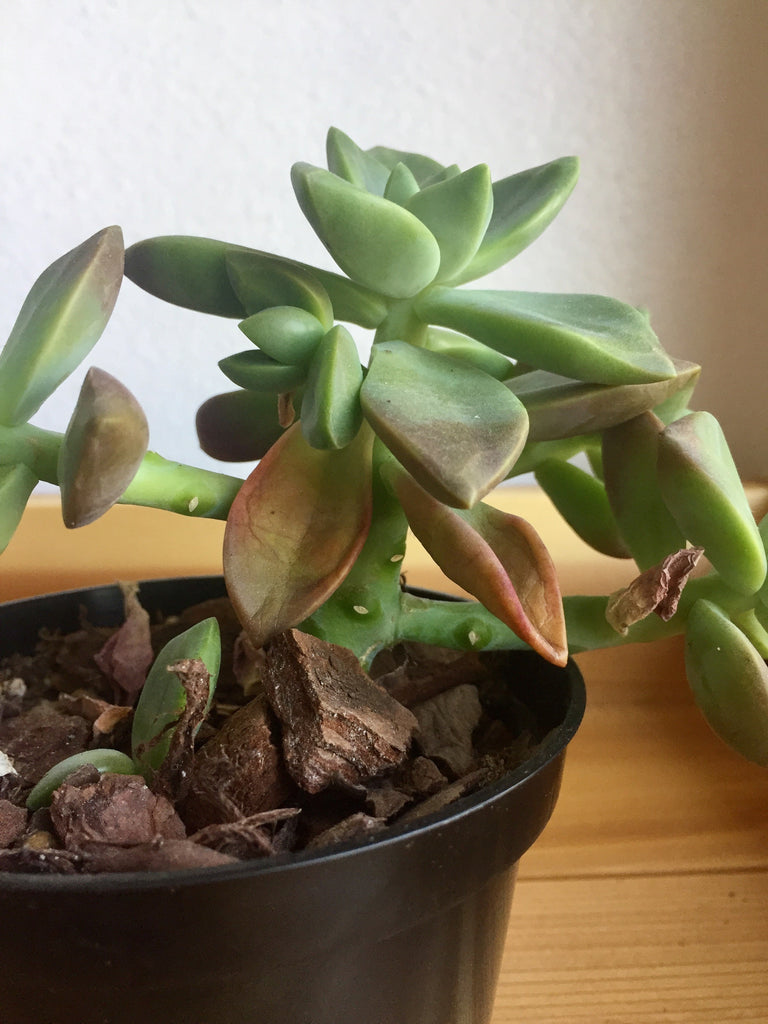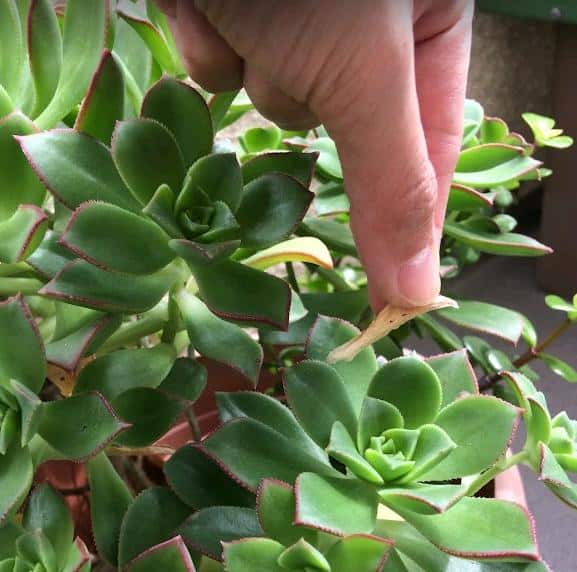Because they are either overwatered or underwatered, succulent leaves shrink. Between waterings, succulents require the soil to completely dry out. The stress makes the leaves shrivel, turn yellow, and become mushy if the soil is wet. Succulents that are underwatered shrink and turn brown.
Table of Contents
How to Differentiate Succulents that Shrivel due to Under Watering or Over Watering
Underwatered leaves shrink and eventually turn brown, whereas overwatered leaves also turn yellow, black, or translucent and have a mushy texture. This is the main distinction between succulents that shrivel from too much or too little water.
Testing the soil for moisture will give you another indication of whether the succulent is being overwatered. If there is any moisture present, feel the soil with your finger via the drainage hole in the container.
Shrunken leaves can be caused by either overwatering or underwatering the soil, depending on how wet it is.
Additionally, the pot’s weight provides information. If it seems lighter than expected, the soil is likely dry, and if it feels heavy, the soil is likely retaining too much moisture.
Read on to learn how to rejuvenate succulent leaves that have been shriveled as a result of either inadequate watering or too much moisture around the roots.
How to Revive Succulents with Shriveled Leaves due to Under Watering
Underwatering is the most likely culprit if it has been more than two weeks since you last watered and your succulent leaves are shriveling up.
The first sign that your succulent needs more water is typically the shriveling of its leaves since succulents store moisture in their fleshy, thick leaves as a defense mechanism against thriving in desert climates all over the world.
The good news is that with more suitable watering frequency, a succulent is likely to recover if its leaves only look to be slightly shriveled.
It is difficult to give general recommendations regarding how often to water succulents because there are so many variables. However, in the majority of cases, watering your succulents once every two weeks is appropriate, though this can vary greatly.
Generally speaking, if you are hydrating your succulent with a decent soak, it should regain its full and plump appearance after two watering cycles.
However, keep in mind things that can accelerate drying or enhance moisture for the succulent and result in shriveled leaves, such as:
- air currents and heat sources. Succulents typically thrive at room temperature, but if they are placed close to a heat source, the soil may evaporate more quickly, which could cause your succulent to shrivel. Currents from air conditioners can help to reduce the humidity around your succulent, which is beneficial for preventing shriveling caused by an excess of moisture in humid conditions.
- climate’s temperature and humidity. Look for early symptoms of leaves shriveling as a reminder to water your succulent because a hotter and drier climate might increase water need. Low humidity is a habitat to which succulents have adapted, and they do well there. Overwatering can be problematic since high humidity slows down the pace at which water is lost through the leaves.
- Sun exposure and sunshine intensity. The amount of sun that different succulents need varies; some enjoy brilliant indirect light, while others prefer partial or full sun. If your succulent needs sunshine, the morning sun is less intense and the temperatures are often cooler, whereas the afternoon sun is more intense and the temperatures are generally warmer, which can cause your succulent to dry out and shrivel more quickly.
Finding the ideal water frequency for your particular succulent type will involve some experimenting. Maintain in mind that it is simpler to revive an underwatered succulent than an overwatered succulent, thus it is preferable to keep your succulent on the dry side.
The succulent should begin to show symptoms of recovery the next week if your leaves are shriveling and it has been some time since your last watering session.
It can be useful to note on paper or in your phone when you last watered your succulent.
(Read my post on how frequently to water succulents to understand how to water succulents at various seasons of the year and under various circumstances.)
Watering too Lightly Causes Shriveled leaves
Succulents don’t require a lot of water, yet occasionally people misunderstand this suggestion and give the plant too little water.
If you water your succulents too little, the top inch or two of the soil may be moist, but the water will not reach the roots where it is needed.
The liquid from the soil then evaporates, leaving your succulent’s roots unable to take in any additional moisture, creating a deficit. The first sign of stress is typically shriveled leaves, and after a prolonged period of drought, the color of the leaves may start to look somewhat brown.
Succulents need a really good soak so that water trickles down the bottom of the pot to make sure the water reaches the roots, even if they shouldn’t be watered too frequently.
Before rewatering, the soil should then be allowed to dry for roughly 14 days (depending on your climate).
This watering schedule replicates the moisture cycle found in the succulents’ natural desert habitat, where plants are occasionally drenched by downpours of rain before experiencing drought-like circumstances.
The answer.
To ensure that you have watered your succulent with the proper amount of water to avoid it from shriveling due to dehydration, always water your succulents until water clearly trickles out the base of the pot (which should have drainage holes).
Shriveling is typically the first sign of stress as a result of watering too lightly, but with proper watering, the succulent should recover nicely.
Hydrophobic Soil Repels Water Away from the Succulents Roots
Some people carefully go by the instructions to water their succulents thoroughly and at the proper intervals, but their succulents still shrivel as if they are too dry.
This is typically because succulents are kept in potting soil that contains peat, which, when it dries up, can become hydrophobic (rejects water).
Some potting mixes can bake to a hard texture, which prevents water from penetrating and reaching the roots of your succulents when soil dries out (as it should between watering your succulents).
Instead, the water is resisted and slides down the soil’s surface, down the edge of your pot, and finally out the pot’s base.
This may give the succulent the appearance of being well-watered when in fact the soil around the roots and below the surface is still dry after watering.
The result of this impact is a prolonged drought that dries up your succulent leaves and causes them to shrink.
The answer.
Repot your succulent and use better potting soil to fill the pot.
In their natural home, succulents thrive in highly arid soil that drains fast and does not retain water around the roots.
Repot your succulent using a special succulent and cactus potting mix that mimics the drainage qualities of the soil found in the succulents’ natural habitat (available at garden centers and on Amazon).
Even when it is completely dry, a specially designed succulent potting soil maintains a porous, aerated structure.
As a result, the soil does not become hydrophobic and water can freely permeate the soil to reach the roots rather than flowing off the top and causing drought.
Succulent soils mimic the nutritional profile of the soil where succulents grow in the wild by including more inorganic material (such as sand and grit at the proper particle size), which drains at the best rate.
Your succulent’s roots can absorb the moisture they need with the correct soil mixture, and they can also drain well to prevent root rot.
Succulents Shriveling due to Over Watering and Excess Moisture
While shriveling is more often a sign of a succulent that hasn’t received enough water, it can also occur when the soil has been overly wet around the roots for a prolonged period of time.
A clear indication of overwatering is when the leaves of a succulent turn yellow or translucent, have a mushy texture, and droop.
The presence of excessive moisture around the roots can result in shriveling and be brought on by:
- very frequent watering of the succulent. Succulents can shrivel and change color if they are overwatered, which is likely the case if you water them more frequently than once per week.
- Potting soil retains too much moisture and is perpetually soggy. Between waterings, the earth must dry out for succulents. Succulents can get shriveled and even rot if the potting soil holds water.
- pots without base drainage holes. To allow excess water to drain, succulents should be planted in containers with drainage holes in the base.
- Saucers and trays. To stop water from overflowing, some people place trays and saucers underneath pots. If these are not routinely emptied, water can collect at the bottom of the pot, soggy soil leads to water stress, which can cause the leaves to shrink.
- humid environments or circumstances. High humidity can slow the rate of water loss from the succulent’s leaves (transpiration). High humidity can cause succulents to shrivel up as a result of water stress because one of the main ways succulents manage the balance of moisture is through water loss through the leaves. The steam that comes from bathrooms and kitchens can also contribute to higher humidity levels.
Since this mimics the moisture balance in the succulents’ desert habitat, succulents need the soil to dry up between waterings.
Therefore, it’s crucial to water the succulent properly and take into consideration any additional sources of excess moisture near the roots that can put the plant under stress.
How to Revive an Over Watered Succulent with Shriveled Leaves
- Restrict the irrigation. The most crucial element is to cut back on watering so that the soil can dry out. Determine when the soil in your succulent plants dries out. To do this, check to see if you can feel any moisture in the soil through the drainage hole. Wait a few days until the soil is completely dry before watering if it is still slightly moist. This might assist you in creating a trustworthy watering schedule to prevent overwatering.
- Change the dirt. In order to prevent overwatering and shriveled leaves, replace any soil that is sluggish to drain with a particular succulent and cactus soil. This soil helps water to drain away from the roots more effectively.
- The succulent should be repotted with drainage holes in the base to ensure appropriate drainage. Some succulents are sold in attractive pots without drainage holes, which prevents water from evaporating and results in an overabundance of moisture near the roots.
- If you can, move your succulent to a room with less humidity. When succulents are kept in bathrooms, they frequently experience water stress. Attempt to place your succulent in a space without artificial humidity. An open window’s breeze may be helpful.
Following each of these guidelines will allow the succulent to have a watering cycle that meets their needs and let the leaves to recover from their shriveled state to a firm, green one.
However, if your succulent’s leaves do not improve after two weeks and begin to change color, you should remove any parts that are becoming black and attempt to replicate the succulent from cuttings and any healthy parts of the plant that are still there.
Succulents naturally reproduce vegetatively through the development of roots in their leaves, making their propagation quite simple. Cutting-based propagation also has a very high percentage of success. To learn how to effortlessly save your succulents, watch this YouTube video:
Key Takeaways:
- Succulent leaves shrink because they do not get enough water or because the soil surrounding the roots is overly wet. The first indication that a succulent needs more water is shriveling leaves. Succulent leaves that have received too much water wilt, turn yellow, and become mushy.
- To prevent withered leaves from underwatering, succulents should receive a good soak-watering once every one to two weeks. Succulents need a soil that drains properly.
- To prevent succulents from shriveling from overwatering, let them dry out between watering sessions and place them in a pot with drainage holes at the base.
- Succulents that have become shriveled and under-watered can be easily rejuvenated by increasing watering frequency, watering more liberally, and switching the potting mix. Succulents that have been overwatered need to dry off before being watered once again.
FAQ
How do you save a shriveled succulent?
Cut off any brown or black roots as they are already rotting. Dig the succulent out of the ground and remove any excess soil that has become stuck to the roots. Place the plant on a mesh or other strainer until the roots have had two to three days to air dry. Replant the roots in the pot once they have dried completely.
Why do succulents go wrinkly?
When they receive too much or not enough water, they’ll let you know. Succulents’ leaves begin to resemble shriveled fingers that have spent too much time in the jacuzzi when they receive too much water. If leaves are overwatered, they frequently turn brown, decay totally, and then start to fall off.
Why are my succulent leaves shriveling?
What to look for to determine if your succulent is submerged is listed below: Shriveled leaves: As a plant’s water supply continues to diminish, its leaves will begin to wrinkle and shrivel. The more severe the water shortage, the more wilted and droopy the plant will appear.
How do you fix wrinkled succulent leaves?
You will need to unpot and then repot the succulent in order to correct these yellow and wrinkled leaves (essentially root rot). The succulent must be unpotted before being allowed to dry out on a paper towel for a couple of days until the roots are entirely dry.



